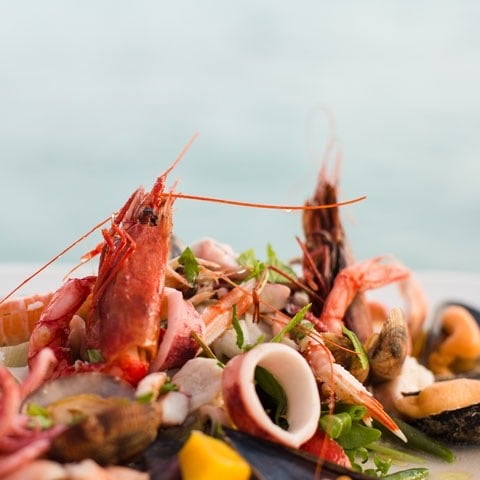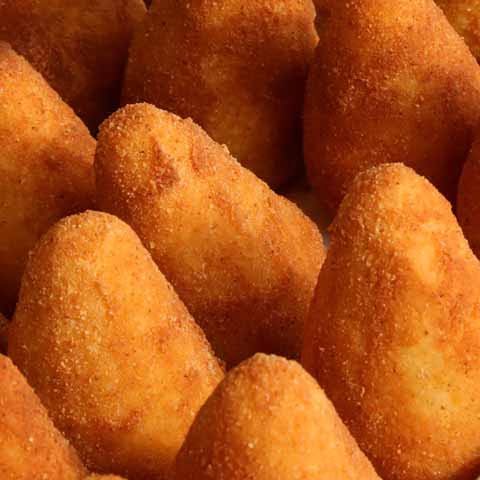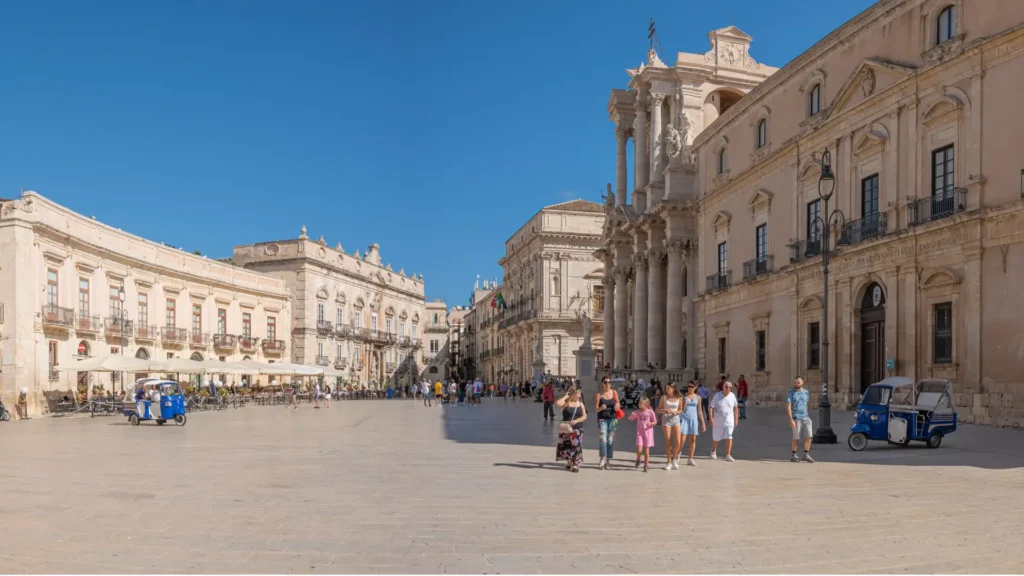Palermo, like Sicily as a whole, is a prime food destination. In particular, the city is known as one of the top locales in the world for street food, while its climate allows for a vast selection of delicious produce to be available year-round in addition to freshly caught local seafood.
The city’s cuisine is influenced by Sicily’s countless multicultural influences, resulting in dishes that are distinct from the rest of Italy. This is particularly evident in the regional sweets derived from Arab influences. Furthermore, Palermo is the capital of one of the top wine production regions of Italy, and wine is always present on dining tables in Palermo, making this city an ideal destination for food and wine lovers alike.
PALERMO’S APPETIZERS
To begin a meal in Palermo, traditional recipes featuring local produce are usually served.
Due to Sicily’s wonderful citrus crop, insalata di arance (orange salad), is common. In this savory dish, oranges are sliced and topped with olive oil, chives, salt, and pepper. In some cases, additional ingredients may be added such as fennel, olives, and parsley. The dish may be served at the beginning of a meal, at the end of a meal, or as a side dish.
Another classic Sicilian appetizer served throughout Palermo is caponata, a fried eggplant dish that is topped with a sauce that is both sweet and sour – a common flavor profile of dishes in Sicily. Ingredients may vary slightly throughout the island. The city of Palermo is considered to prepare the most simple and classic version of this dish with the common ingredients being local eggplant, green or white olives, onion, celery, capers, tomato sauce, olive oil, salt, vinegar, and sugar. Some residents of Palermo may also add basil, pine nuts, and grated toasted almonds.
Travelers should also expect fried vegetables at the beginning of a meal. The most common assortment of fried vegetables in Palermo is called cardi, broccoli e carciofi in pastella. The dish features cardoons, broccoli, and artichokes that are lightly battered and fried.
One of the most popular cheeses in Palermo is cacciocavallo, which is an aged cheese made from cow’s milk. During the aging process, it is hung from a beam, giving the cheese its characteristic figure 8 shape. The cheese is featured in many local appetizers, first courses, second courses, and street food. The other typical cheese in the area is ricotta, which is an integral component of Palermo’s desserts.
Arancine (the feminine version of the word, arancina, is used in Palermo and western Sicily, while in eastern Sicily the masculine form, arancino, is typically used) are delicious, crispy, deep fried balls of rice iconic of Sicilian cuisine. Translated literally, arancine means little oranges since these tasty creations resemble oranges both in color and in shape. The most traditional fillings feature rice flavored with saffron plus ragù, peas, and caciocavallo or tomato sauce and mozzarella. Outside of the traditional fillings, it is possible to find arancine filled with a variety of local ingredients. The beauty of this tasty recipe is that it can be customized with different fillings. In Palermo, arancine may be served as an appetizer, as well as a street food.
PALERMO’S FIRST COURSE
For the pasta course in Palermo, travelers should expect traditional pasta in various sauces as well as a variety of baked pasta dishes. One of the most popular is anelletti al forno, which features ring shaped pasta baked with ragù and peas. Other ingredients that may be added include prosciutto, hard-boiled eggs, mozzarella, or pecorino.
The other principal pasta dish in Palermo is pasta con le sarde, a pasta and sardine dish that reigns supreme in Sicily. Typically served with bucatini pasta, the primary ingredients are fresh, local sardines and wild fennel. The classic preparation of this dish frequently also includes onions, saffron, raisins, and pine nuts to create the quintessential sweet and sour flavor that is prevalent throughout the area. Toasted breadcrumbs are usually the finishing touch, resulting in a tasty and unique dish.
A similar local recipe, pasta c’anciòva, features pasta with salted anchovies and toasted breadcrumbs.
SECOND COURSE IN PALERMO
The second course, or meat course, in Palermo typically consists of seafood – a Sicilian specialty – or meat from lamb, goat, cow, and sometimes chicken.
Perhaps the most popular seafood recipe is sarde a beccafico, a baked dish that consists of sardines wrapped around a mixture of breadcrumbs, minced garlic, parsley, raisins, pine nuts, salt, pepper, and olive oil. The dish is often offered at Palermo’s street markets or at restaurants as a second course or appetizer. It can be found in other parts of Italy as well such as Trapani, Agrigento, Messina, and Catania.
For adventurous seafood eaters, try boiled octopus. Served fresh from the waters, the octopus is boiled and cooked until tender, then cut up and topped with lemon juice. It is usually accompanied by potatoes, but may also be served on its own.
Another common seafood second course dish is polpette di sarde. These sardine meatballs are made with local sardines, caciocavallo, breadcrumbs, egg, garlic, raisins, pine nuts, and mint. Polpette di sarde can either be pan fried or cooked in tomato sauce.
One of Palermo’s popular meat-based dishes is involtini alla palermitana, or meat rolls in the style of Palermo. They are made by wrapping slices of veal around a filling of breadcrumbs, caciocavallo , raisins, and pine nuts then seasoned with salt, pepper, and herbs. The involtini are pan seared to impart a nice crust.
Cotoletta, a breaded and fried cutlet, is a classic Italian dish and most people are familiar with the Milanese version, yet there is also cotoletta alla palermitana, or cototella Palermo style. Considered to be a lighter alternative to the Milanese cotoletta, cotoletta alla palermitana is not made with butter or eggs. The breading features coarse breadcrumbs, pecorino, parsley, garlic, and chives. In Palermo, cotoletta is not fried, but rather it is baked or grilled.
Carne allo sfincione is a beef dish beloved by the locals. To make carne allo sfincione, steaks are salted and topped with minced anchovies, sliced caciocavllo, tomato sauce, breadcrumbs and oregano. The steaks are then baked and the result is tender and flavorful meat.
Though not an everyday recipe, another dish local to Palermo is babbalùci. Consisting of boiled snails seasoned with olive oil, garlic, and parsley, this recipe is usually prepared by the locals for dinner on the feast day of Santa Rosalia, the patron saint of Palermo.
PALERMO’S SIDE DISHES
Most side dishes in Palermo and the rest of Sicily feature locally grown in-season vegetables. One of Palermo’s characteristic side dishes is favi a cunigghiu or fave a coniglio. This simple dish, which originated as part of the local peasant cuisine, consists of fava beans, olive oil, garlic, bay leaves, and oregano. The fava beans are cooked slowly and, depending on preference, may have a soup-like consistency or a dryer texture. The name of the dish, which can be translated as fava beans rabbit style, refers to the fact that at one time this dish was shared and each person would grab a fava bean, hold it between their thumb, index, and middle finger, and extract the fava bean from its skin with their incisors, almost like a rabbit does with seeds.
STREET FOOD IN PALERMO
In Palermo, street food is a much-loved tradition that goes back centuries. Street food culture represents the history of area, when poverty caused people to be practical with their dishes and ingredients.
Some of the classic street foods in Palermo are:
arancine – Stuffed, fried rice balls (see appetizer section for more details).
panelle – Fritters made from a batter of chickpea flour, water, and parsley. These are often served in a local sesame seed bread, resulting in a sandwich called pane e panelle. Panelle are considered to be the most characteristic snack of Palermo.
pani câ mèusa – As the “king” of Palermo’s street food, this recipe consists of a sandwich made with local sesame seed bread that is filled with veal spleen, lung, and trachea. The veal is boiled or steamed then sliced thin and cooked slowly in lard. The veal may be accompanied by caciocavallo, in which case the sandwich is referred to as maritatu (married). Without the cheese, it is called schettu (single) and may be seasoned with a few drops of lemon juice.
sfincione – A local version of pizza, sfincione has a distinctive porous dough that is soft, thick, and reminiscent of a sponge. It is usually topped with plain tomato sauce or tomato sauce with salted sardines, onions, cheese, and olive oil. Sfincione may be served as an appetizer in Palermo as well.
cazzilli or crocchè di patate – Potato croquettes made with milk, cheese, parsley, and black pepper. They may be served together with panelle or pane e panelle or simply with bread (and in this last case the dish is called pane e crocchè).
stigghiola – Offered as a street food and in local restaurants, stigghiola consists of lamb intestines (and sometimes veal or kid intestines), that are carefully cleaned with salt and water then skewered and grilled. Stigghiola can be purchased at special stands that only serve this particular street food.
raschiatura – After making panelle and crocchè di patate, usually there is leftover dough. In some cases, this is be mixed together with potatoes, parsley, and other spices, formed into triangles, and then fried.
iris – One of Palermo’s sweet street foods, iris consists of a doughnut that is filled with ricotta cream, sugar, melted chocolate, and pieces of chocolate.
PALERMO’S DESSERTS
Sweet treats can be found at restaurants, cafés, and pastry shops throughout Palermo. In fact, Palermo is particularly renowned for its historic pastry shops where delicious local sweets, that usually feature ricotta cream, are sold.
Of course, cannoli are prominent throughout the city, as they are Sicilian in origin. Cannoli are tube-shaped wafers that are filled with a sweet ricotta filling and additions like candied fruit, chocolate, nuts, and powdered sugar.
Another classic dessert in Palermo and the rest of Sicily is cassata – a round sponge cake that is moistened with fruit juice or liqueur and layered with sweet ricotta filling and candied orange peel. The cake is covered with marzipan, icing designs, and candied fruits such as cherries and citrus. In Palermo there is also a version called cassata al forno that does not have marzipan or candied fruits. Rather, cassata al forno is made with short crust pastry that is filled with ricotta cream and dark chocolate chips. After baking, the cake is covered with powdered sugar.
Other sweets that are popular throughout Palermo are pieces of marzipan shaped like fruit, called frutta martorana. Dating back to the thirteenth or fourteenth century, this typical Sicilian sweet is said to have Arab influences. It is believed that the nuns residing in a monastery connected to Palermo’s Church of Santa Maria dell’Ammiraglio, also called Martorana, are the inventors of frutta martorana as it is known today.
According to legend, the nuns of this monastery were renowned for their remarkable garden filled with fruits and vegetables. Word spread of their bounty and when the bishop of the area heard about the garden he decided to visit. Unfortunately for the nuns, the visit coincided with All Saints’ Day and their trees did not produce fruit in November. To remedy the situation, the nuns created fruits out of marzipan to decorate the barren trees and restore beauty to the garden. Today, frutta martorana can resemble all types of fruits, each with vibrant colors and remarkable flavors.
A special treat made for All Souls’ Day, pupi di zucchero are hollow, anthropomorphic statues made of sugar that are decorated with bright colors. Made in Palermo for centuries, the sweet statues are tied to the Opera dei Pupi and depict typical characters of the puppet show including paladins, commoners, ballerinas, and other traditional figures. More recently, some pupi di zucchero have been made resembling popular soccer players or other celebrities.
Palermo is also the birthplace of several other sweets linked to religious celebrations. One example is sfincia di San Giuseppe, a fist-sized pastry that is fried in lard until golden. Sfincia is topped with ricotta cream, pieces of chocolate, candied squash, and garnished with candied orange peel. Invented for the Feast of St. Joseph on March 19, originally sfincia was only made in connection with the holiday, but today it is available in Palermo year-round.
On November 11, the locals of Palermo celebrate the Feast of St. Martin with biscotti di San Martino. These delicious cookies are made in two versions, hard and soft. The hard version consists of a dry cookie with an anise aroma that is baked three times. Due to the texture, the cookies are typically dipped in a dessert wine and then eaten. The soft version is baked twice and filled with ricotta cream or citron marmalade. The soft cookie with ricotta cream is called rasco, while the one with citron marmalade is called decorato because it is decorated with a sugar glaze.
Cuccìa, a characteristic dessert in Palermo and Syracuse, is traditionally made for the Feast of St. Lucy on December 13. The dish consists of boiled wheat served with ricotta cream and garnished with candied squash, cinnamon, pieces of chocolate, and orange zest.
Like the rest of Italy, Palermo is filled with artisanal gelaterie (gelato shops), however Palermo may also be tied to the history of the iconic dessert. It is believed that Francesco Procopio dei Coltelli, a seventeenth and eighteenth century Siclian cook and gelato pioneer, may have been born in Palermo. Dei Coltelli perfected his gelato in Sicily and other parts of Italy before traveling to Paris. Dei Coltelli is credited with opening the first café to serve gelato in Paris (now the oldest Parisian café), and from there word of Italian gelato spread throughout Europe. For this reason, dei Coltelli is considered to be one of the fathers of gelato.
Whether dining on cassata after a big meal or just picking up a cannoli while sightseeing, tasty sweets will be the perfect end to perfect days in Palermo.
WINE
In Sicily, 80% of the region’s wines come from three provinces – Trapani, Agrigento, and Palermo. The wines of Sicily are high quality and reflect the multicultural heritage of the region. As one of Italy’s top wine-producing regions, wine is always present during a traditional Sicilian meal.
Throughout Palermo, travelers can enjoy many DOC wines, such as Alcamo, which is produced in an area around Palermo and is available in mostly white varieties, but also a few red varieties. Red Alcamo wines are usually made from Nero d’Avola grapes, while white Alcamo wines can be made from Grillo, Catarratto, Inzolia, or Grecanino grapes.
In nearby Monreale, the Monreale Bianco DOC wine is produced. This white wine is known for its elegant aroma and dry, delicate taste.
Palermo has countless wine shops featuring some of the best selections of Sicilian wines, in addition to a wide variety of wines from across Italy. Palermo is also about a 2-hour drive from Marsala, where the famous Marsala wine is produced.
Outside of wine, Anice Unico Tutone is a liqueur that was invented in Palermo. Dating back to the early nineteenth century, the official recipe is a secret, but the liqueur is flavored with anise and cumin. Known for its high alcohol content, locals typically add a few drops of Anice Unico Tutone to a cool glass of water, though it can also be used to make fruit cocktails or Sicilian desserts.
From delicious pasta dishes and fresh seafood to an extensive street food culture, Palermo’s cuisine is in a league of its own. Providing a perfect blend between historic culinary traditions and innovative techniques, Sicily’s lively capital is a haven for lovers of food and wine.
Travel Guides
The Sicily Region of Italy
The Cities of Sicily, Italy











